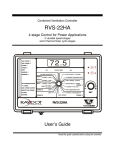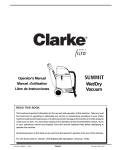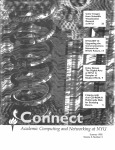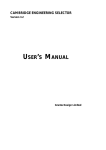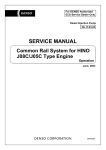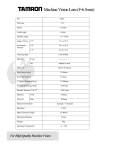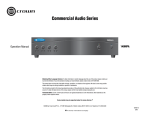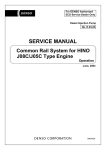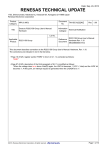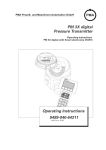Download Ray-Dot RVS-22HA Installation guide
Transcript
Combined Ventilation Controller RVS-22HA 4-stage Control for Power Applications 2 variable speed stages and 2 thermo/mister cycle stages 72.5 VAR STAGE 1 VAR STAGE 2 STAGE 3 A STAGE 4 MIST ROOM TEMP. MIN MAX HEATER 1 HEATER 2 B ALARM OFFSETS HEAT 1 HEAT 2 RH COMPENSATION T° CURVE MIN. SPEED CURVE DEFECTIVE PROBE MIST OFFSET / DIFF. CURRENT RAMPING DAY OFFSET / DIFF. MIN. SPEED / CURVE OFFSET / DIFF. BANDWIDTH / TIMER STAGE 1 HUMIDITY MIN / MAX ON (SEC.) TIMER OFF (MIN.) STAGE 3 ALARM LOCKED SET POINT / T°CURVE STAGE 4 DIFF. RH COMPENSATION DIFF. OFFSET / BANDWIDTH MIN. SPEED SET STAGE 2 RVS-22HA Installation Guide Read this guide carefully before installing the controller. PRECAUTIONS We strongly recommend connecting the controller to an alarm system, and installing a supplementary natural ventilation system as well as a back-up thermostat on at least one cooling stage. Refer to the wiring diagram enclosed with this installation guide to connect the thermostat. Inputs and outputs circuitry is protected against overload and overvoltage. However, we recommend installing an additional protection device on the supply circuit as well as an external relay on all ON-OFF stages to prolong the life of the controller. To avoid exposing the controller to harmful gases or excessive humidity, it is preferable to install it in a corridor. The room temperature where the controller is located MUST ALWAYS REMAIN BETWEEN 32° AND 104°F (0° AND 40°C). DO NOT SPRAY WATER ON THE CONTROLLER. FOR CUSTOMER USE Enter below the serial number located on the side of the controller and retain this information for future reference. Model number: RVS-22HA Serial number: ________________ TABLE OF CONTENTS FEATURES ......................................................................................................................2 CONTROL INTERFACE ..................................................................................................4 COVER.................................................................................................................................. 4 DIP SWITCHES..................................................................................................................... 6 INSTALLATION ...............................................................................................................7 MOUNTING INSTRUCTIONS................................................................................................ 7 CONNECTIONS .................................................................................................................... 7 Alarm Connection ............................................................................................................ 7 MOTOR TYPES .................................................................................................................... 8 Selecting a Motor Type for Stage 1.................................................................................. 8 Selecting a Motor Type for Stage 2.................................................................................. 8 TEMPERATURE UNITS ........................................................................................................ 8 TEMPERATURE PROBES.................................................................................................... 9 Connecting the Probes .................................................................................................... 9 Extending the Probes....................................................................................................... 9 Installing the Room Probes .............................................................................................. 9 Installing the Humidity Probe ......................................................................................... 10 Defective Probes............................................................................................................ 10 TROUBLESHOOTING GUIDE .......................................................................................11 TECHNICAL SPECIFICATIONS ....................................................................................14 FACTORY SETTINGS ...................................................................................................15 WIRING DIAGRAM ........................................................................................................17 NOTES ...........................................................................................................................18 RAYDOT Ventilation Control Page 1 FEATURES The RVS-22HA is a powerful environmental controller that can manage two variable ventilation stages and two on/off ventilation/mist/heater stages. The “room temperature” is the temperature averaged from 1 to 4 probe readings. Heaters follow either the room temperature or a zone temperature, depending on user setup. A humidity probe may be used to lower the humidity level by activating stage 1 or by deactivating the mist stage. It is important to read both the RVS-22HA User’s Guide and the present Installation Guide. The Installation Guide provides information on physical characteristics of the controller, mounting, connections, probes, troubleshooting and technical specifications. The User’s Guide explains the workings of the controller parameters. RVS-22HA highlights: Displays absolute temperatures for all stages Temperature readings and high/low for both room and individual readings Selectable 2.0°F (1.1°C) offset for all on/off stages Optional humidity probe (reading and high/low) with relative humidity compensation Alarms for high, low and critical temperatures; power failure alarms Test mode Set point and minimum ventilation curve, with 10 easily adjustable points Temperature available in °C or °F units Up to two heating stages (zoned or cascading) De-icing on variable stage 2 Standard alarm output CSA approved for both the United States and Canada Control of air inlets with potentiometer feedback (must be used in combination with RV-F-1A module) Page 2 RAYDOT Ventilation Control RVS-22HA Installation Guide Here is a brief description of the RVS-22HA main features. Digital display A three-digit display provides a high level of accuracy, allowing the user to specify a temperature to within one tenth of a degree (in Fahrenheit or Celsius units). Pilot lights Pilot lights indicating the status of outputs allow you to monitor the operation of the system from a distance. Minimum ventilation cycle When ventilation is not required for cooling, the first stage fans can be operated either continuously or intermittently to reduce the level of humidity and supply oxygen to the room. Temperature and minimum ventilation speed curves The controller can be set to automatically change the temperature set point and the minimum ventilation speed over a given period of time in accordance with the user’s requirements by specifying a temperature curve and a minimum ventilation speed curve with up to ten different points each. Choice of ten motor types The variation in motor speed resulting from a change in voltage will depend on the make and capacity of the motor. In order to achieve a high degree of compatibility between controller and motor, the user can choose from ten different motor types, thus ensuring that the correct voltages are supplied. Humidity compensation As humidity increases, the minimum speed of stage 1 fans increases proportionally to compensate for the change. Full speed fan start up In order to overcome the inertia of the ventilation system components and de-ice the fan blades in cold weather conditions, the controller supplies maximum voltage to the variable speed fans during the four seconds that immediately follow start-ups. Four independent temperature probe inputs Up to four temperature probes can be connected to the controller in order to obtain a more accurate reading of the average room temperature. Overload and overvoltage protection Inputs and outputs circuitry is protected against overload and overvoltage. Test mode A test mode allows the user to simulate temperature changes and verify controller performance. RAYDOT Ventilation Control Page 3 RVS-22HA Installation Guide CONTROL INTERFACE COVER 1 2 3 4 72.5 VAR STAGE 1 VAR STAGE 2 STAGE 3 A 13 pilot lights STAGE 4 MIST ROOM TEMP. MIN MAX HEATER 1 HEATER 2 B ALARM OFFSETS HEAT 1 HEAT 2 RH COMPENSATION T° CURVE MIN. SPEED CURVE DEFECTIVE PROBE MIST SET POINT / T°CURVE OFFSET / DIFF. CURRENT RAMPING DAY OFFSET / DIFF. MIN. SPEED / CURVE OFFSET / DIFF. BANDWIDTH / TIMER STAGE 1 HUMIDITY MIN / MAX ON (SEC.) TIMER OFF (MIN.) STAGE 3 ALARM LOCKED 5 DIFF. RH COMPENSATION DIFF. STAGE 4 OFFSET / BANDWIDTH MIN. SPEED SET STAGE 2 RVS-22HA Page 4 RAYDOT Ventilation Control RVS-22HA Installation Guide Item Name Function Digital display Displays the value of the parameter selected. 2 Parameter selection knob Used to select a parameter. 3 Push button A Used to access sub-parameters. 4 Push button B Used to access sub-parameters. 5 Adjustment knob Used to adjust the value of the selected parameter and to access the TEST MODE (for an explanation on the test mode, see the footnote in the Factory Settings section). Variable stage 1 Lights up when the fan variable stage 1 is activated. Variable stage 2 Lights up when the fan variable stage 2 is activated. Stage 3 Lights up when stage 3 is activated. Stage 4 Lights up when stage 4 is activated. Mist Turns on when the mister cycle stage is activated. Heater 1 Lights up when heater 1 is activated. Heater 2 Lights up when heater 2 is activated. RH compensation Turns on when compensating for relative humidity. Temperature curve Is on when the temperature curve is activated. Minimum speed curve Is on when the minimum speed curve (stage 1) is activated. Defective probe Turns on when a probe is defective. Alarm Lights up to signal an alarm. Locked Is on when parameter settings are locked. 13 pilot lights 1 RAYDOT Ventilation Control Page 5 RVS-22HA Installation Guide DIP SWITCHES These internal switches, located on the electronic card attached to the back of the cover, are used to set the operating modes described in the table below. When the controller is shipped from the factory, all the switches are set to off. The 12 DIP switches DESCRIPTION DIP SWITCH NO. Locking the parameters 1 Reserved 2 Probe 2 3 Probe 3 4 Probe 4 5 Cooling or heating 6 and 7 Temperature heater 8 Mist 9 Offset on ventilation stages 10 De-Icing 11 Reserved 12 Page 6 POSITION ON OFF DIP ON DIP ON DIP ON 1 2 3 4 5 9 6 7 8 11 12 OPERATING MODE Locked parameters Unlocked parameters Reserved ON OFF ON OFF ON OFF 6: OFF and 7: ON or OFF 6: ON and 7: ON 6: ON and 7: OFF ON OFF ON OFF ON OFF ON OFF Enabled Disabled Enabled Disabled Enabled Disabled Stage 3 Fan Stage 4 Fan Stage 3 Heater Stage 4 Heater Stage 3 Fan Stage 4 Heater Zoned Heaters Cascading Heaters Enabled Disabled 2.0°F(1.1°C) offset on ventilation stages No offset on ventilation stages Enabled Disabled Reserved RAYDOT Ventilation Control RVS-22HA Installation Guide INSTALLATION MOUNTING INSTRUCTIONS The enclosure must be mounted in a location that will allow the cover to be completely opened right up against the wall. Fasten the four brackets to the four mounting holes on the back of the enclosure, using the four screws provided with the brackets. Then mount the enclosure on the wall by inserting screws through the brackets’ adjustment slots, into the wall. Make sure to position the enclosure so that the power supply cord extends out of the bottom section of the enclosure. The bracket slots also serve to adjust the position of the controller. Once you have adjusted the controller position, tighten the four mounting screws. CONNECTIONS To connect the controller, refer to the wiring diagram enclosed with this installation manual. 1. Set the voltage switch to the appropriate line voltage. 2. Drill access holes on the bottom of the enclosure only. Do not drill holes on the side or the top of the enclosure. 3. It may be necessary to install a transformer on the heating stage in order to supply the appropriate voltage to the heating unit. Alarm Connection There are two types of alarms on the market. One type sets off when current is cut off at its input; the other sets off when current is supplied at its input. For the first type of alarm, use the NO terminal as shown on the wiring diagram. For an alarm of the second type, use the NC terminal. WARNING ALL WIRING MUST BE DONE BY AN AUTHORIZED ELECTRICIAN AND MUST COMPLY WITH APPLICABLE CODES, LAWS AND REGULATIONS. BE SURE POWER IS OFF BEFORE DOING ANY WIRING TO AVOID ELECTRICAL SHOCKS AND EQUIPMENT DAMAGE. RAYDOT Ventilation Control Page 7 RVS-22HA Installation Guide MOTOR TYPES The relationship between the voltage supplied to a motor and its operating speed is described by a motor type. This type varies with the make and capacity of the motor. The various motors available in the industry have been represented. Select the appropriate type to ensure that the controller supplies the correct voltage to the stage 1 and 2 variable speed fan motors. The factory default selection is type number 10. MOTOR TYPES TYPE NUMBER BRAND NAME MODEL DIAMETER VOLTAGE 1 to 8 Other Val-Co Val-Co Val-Co Val-Co Val-Co Val-Co Val-Co Val-Co — FW08W120MSA FW10W130MSA PM12^140MPA PM16^140MPA PM21^140MPA PM21^190LPA PM24^210MPA PM36^280M*A — 8” 10” 12” 16” 21”, 3 blades 21”, 4 blades 24” 36” — 9 10 230 V 230 V Selecting a Motor Type for Stage 1 In the motor types table above, locate the make and capacity of your stage 1 variable speed motors and note the corresponding type number (1 to 10). 1. Set the parameter selection knob to BANDWIDTH/TIMER (STAGE 1). bandwidth appears flashing on the display. The stage 1 2. Press the push-button . The message “tyP” appears on the display, alternating with the currently selected type number, which flashes. 3. Using the adjustment knob, adjust the type number to the desired value. Selecting a Motor Type for Stage 2 Repeat the steps described for stage 1, this time setting the parameter selection knob to MIN. SPEED (STAGE 2). TEMPERATURE UNITS This product is available in both Celsius and Fahrenheit temperature units. Please contact your dealer for more details. Page 8 RAYDOT Ventilation Control RVS-22HA Installation Guide TEMPERATURE PROBES Connecting the Probes The controller is supplied with one room probe connected to terminal # 1. CAUTION The probes operate at low voltage and are isolated from the supply. Be sure that probe cables remain isolated from all high voltage sources. In particular, do not route the probe cables through the same electrical conduits as other cables. Do not run probe cables next to other power cables. If crossing over other cables, cross at 90°. Connect the probe shield to the power supply ground terminal. Switches are used to activate or deactivate the additional probes connected to the controller. Activate each additional probe by setting the appropriate switch to on. – – – Switch # 3 activates the probe connected to input # 2; Switch # 4 activates the probe connected to input # 3; Switch # 5 activates the probe connected to input # 4. Extending the Probes Each probe can be extended up to 500 feet (150 meters). To extend a probe: 1. Use a shielded cable of an outside diameter ranging between 0.245 and 0.260 in. (6.22 and 6.60 mm) to ensure the cable entry is liquid-tight. Cable size should not be under 18 AWG. 2. It is preferable to solder the cable joints (to ensure a proper contact between the two cables) and to solder the shields. Installing the Room Probes The building may be separated in two heating zones. Depending on how many inside probes are activated, the zones will be divided differently. PROBES CONTROLLING HEAT ZONES Activated Probes Probe(s) Controlling Zone A Probe(s) Controlling Zone B ROOM TEMP. averaged from which probe reading(s) 1 1 1 1 1,2 1 2 1,2 1,3 1 3 1,3 1,4 1 4 1,4 1,2,3 1,2 3 1,2,3 1,2,4 1,2 4 1,2,4 1,3,4 1 3,4 1,3,4 1,2,3,4 1,2 3,4 1,2,3,4 RAYDOT Ventilation Control Page 9 RVS-22HA Installation Guide Installing the Humidity Probe Install the humidity probe in the middle of the controlled area, where there is good airflow. Defective Probes Room Temperature Probes If an activated probe is defective or missing, the defective probe pilot light turns on. The display shows the value of the temperature measured by the remaining room probe(s), and the controller operates according to this temperature. If all room probes are defective or missing, the screen will display “P Lo” when the parameter selection knob is set to ROOM TEMP., and the controller will operate as if all temperature readings were equal to the Set Point. To identify the defective probe: Set the selection knob to ROOM TEMP. The room temperature is displayed. A MIN ROOM TEMP. MAX B SET Press push-button A or B until the screen displays “Pr#” (Probe # [number]). If the probe connected to the corresponding terminal is not defective, the screen displays “Pr#” alternating with the temperature measured by the corresponding probe. Otherwise, the letter displays “Pr#” alternating with “Pr#Lo” or “Pr#Hi”. Humidity Probe If the humidity probe is defective or if there is no humidity probe, the defective probe pilot light does not turn on, but the display shows the letter “P Lo” or “P Hi” when the parameter selection knob is set to STAGE 1 HUMIDITY (refer to “Stage 1 Humidity Readout” in the User’s Guide). Page 10 RAYDOT Ventilation Control RVS-22HA Installation Guide TROUBLESHOOTING GUIDE PROBLEM There is no display. CAUSE SOLUTION The circuit breaker on the service panel is off or tripped. Reset the circuit breaker. The wiring is incorrect. Correct the wiring. The input fuse is open. Replace the fuse. The voltage selector switch is in the wrong position. Set the switch to the correct position. The display board interconnect cable is not properly plugged into the power supply board. Be sure the cable is firmly plugged in. All activated probes are improperly connected. Make the correct room probe connection. All activated probes are defective. Refer to “Defective Probes”. The defective probe pilot light is on. One or more probes are defective. Refer to “Defective Probes”. The display shows sudden variations in the room temperature. A variation in resistance is induced on a probe. Be sure the probes are dry. Locate them away from drafts and sources of radiant heating. There is electrical noise near a probe cable. Isolate the probe cables from all high voltage sources. Do not route probe cables and other power cables through the same electrical knockout. Do not run probe cables next to other power cables. When crossing other power cables, cross at 90°. The wiring is incorrect. Be sure that each variable speed fan is properly connected to the corresponding VARIABLE STG1 & STG2 terminals. Each fan requires two wires to be connected. The stage 1 and 2 fuse is blown. Replace the fuse. The minimum speed is too low. Adjust the minimum speed to a higher value. The fan motor is defective. Check if the motor is defective by connecting it to an alternate power supply. If it still is not operating, replace the motor. The display shows “P Lo” or “P Hi” when the parameter selection knob is set to ROOM TEMP. The stage 1 or 2 variable speed fan is not running. RAYDOT Ventilation Control Page 11 RVS-22HA Installation Guide PROBLEM The stage 1 or 2 variable speed fan runs continuously at full speed. The stage 1 or 2 variable speed fan runs erratically. CAUSE The wiring is incorrect. The ambient temperature is above the set point + bandwidth. The selected motor type is inappropriate The bandwidth is too small. The stage 1 on time or off time is too short. A variation in resistance induced on a room probe causes this probe to measure sudden variations in the room temperature. Electrical noise near a room probe cable causes this probe to measure sudden variations in the room temperature. Stage power are not in phase with line power. The stage 1 variable speed fan runs continuously when the room temperature is below the room set point or when the controller operates in minimum ventilation cycle. Stage 3 (fan, heater 2 or mist), or stage 4 (fan, heater 1 or mist) is not functioning properly. The mist is not operating as desired. Page 12 The stage 1 off time is set to zero. The wiring is incorrect. Humidity compensation is activated and relative humidity exceeds the humidity set point. The wiring is incorrect. The fan motor, heater or mist is defective. The controller is defective. The mist on time and off time were incorrectly adjusted. SOLUTION Fix the wiring. Adjust the set point or bandwidth to the desired value. Select an appropriate motor type. Refer to “Motor Types”. Adjust the bandwidth to a higher value. Adjust the stage 1 on time or off time to a higher value. Be sure the room probes are dry. Locate them away from drafts and sources of radiant heating. Isolate the room probe cables from all high voltage sources. Do not route probe cables and other power cables through the same electrical knockout. Do not run probe cables next to other power cables. When crossing other cables, cross at 90°. Be sure that the stage power and line power are in phase. Set the stage 1 off time to a value other than zero. Be sure that two wires connect the stage 1 fan to the corresponding VARIABLE STG1 terminal. Adjust the humidity set point or deactivate compensation, as required. Be sure that two wires connect each stage to the corresponding terminal. Check if the motor, heater or mist is defective by connecting it to an alternate power supply. If it still is not operating, replace the motor or heater. Listen to check if there is a clicking sound when the stage or heater-mist pilot light turns on. If there is no clicking sound, your controller needs repair. The mist on time is in seconds, and its off time is in minutes. Adjust the mist on time and off time correctly. RAYDOT Ventilation Control RVS-22HA Installation Guide PROBLEM The alarm doesn’t work properly. CAUSE The alarm’s fuse is blown. The wiring is incorrect. The alarm is defective. The controller is defective. RAYDOT Ventilation Control SOLUTION Replace the fuse. Correct the wiring. Refer to “Alarm Connection”. Verify if the alarm unit is defective by connecting it to an alternate power supply. Replace the alarm unit if it still is not operating. Listen to check if there is a clicking sound when the alarm pilot light turns on. If there is not clicking sound, contact your distributor to have the controller repaired. Page 13 RVS-22HA Installation Guide TECHNICAL SPECIFICATIONS DESCRIPTION Page 14 VALUE Input power 10 W Power source (line) 115/230 VAC, -20%, +10%, 50/60 Hz Power fuse 0.125 A @ 250 V, slow blow, 5 X 20 mm Stages 3 and 4 10 A @ 125/250 VAC 1 HP @ 250 VAC ½ HP @ 125 VAC Stage 1 and stage 2 10 A @ 115/230 VAC Minimal charge: 25 mA @ 50/60 Hz Alarm relay 1 A @ 30 VDC Stage 1 and stage 2 power source 115/230 VAC, -20%, +10%, 50/60 Hz (same power as line power) Stage 1 and stage 2 fuse 15 A @ 250 VAC, slow blow Storage temperature -4°F to 130°F (-20°C to 55°C) Operating temperature 32°F to 120°F (0°C to 50°C) Temperature range – inside probes -6.0°F to 168.6°F (-21.1°C to 75.9°C) Weight 5.2 lbs. (2.36 kg) Dimensions 11” X 7” X 6” (27.9 X 17.8 X 15.2 cm) RAYDOT Ventilation Control RVS-22HA Installation Guide FACTORY SETTINGS ROOM TEMP. Position Parameter A↑ ↑ B↓ ↓ Factory Setting ROOM TEMP. MIN./MAX. Room Temp. Readout Lo Hi Probe 1 Readout Probe 1 Lo Probe 1 Hi Probe 2 Readout Probe 2 Lo Probe 2 Hi Probe 3 Readout Probe 3 Lo Probe 3 Hi Probe 4 Readout Probe 4 Lo Probe 4 Hi Test Mode* Software Version — — — — — — — — — — — — — — — OFF 2 SET POINT/ T°CURVE Set Point Adjust Day Adjust Temperature 75.0°F (24.0°C) — — -40.0 to 100.0°F (-40.0 to 40.0°C) 1 to 255 -40.0 to 100.0°F (-40.0 to 40.0°C) CURRENT RAMPING DAY Current Day Adjust Current Day OFF OFF, 1 to 255 MIN. SPEED/ CURVE Minimum Speed Adjust Day Adjust Minimum Speed 40 — — 12 to 100% OFF, 1 to 255 12 to 100% Bandwidth Min. Ventilation On Time Min. Ventilation Off Time Motor Type 2.0°F (1.0°C) 15 0 10 0.5 to 20.0°F (0.3 to 11.0°C) BANDWIDTH/ TIMER HUMIDITY MIN./MAX. Readout Lo Hi — — — 10 to 90 RH% R.H. COMPENSATION Compensation Option Humidity Set Point R.H. Speed Compensation OFF 65 50 ON/OFF 10 to 90 RH% 0 to 100% SET POINT STAGE 1 Range of Values -6.0 to 168.6°F (-21.1 to 75.9°C) 2 0 to 900 seconds 1 to 10 * The Test Mode simulates a temperature reading, allowing the user to test the control’s reaction at a given temperature. To access the Test Mode, the user must position the parameter selection knob to ROOM TEMP. and press pushbutton A or B until “tESt” appears alternating with “OFF” on the display. To activate the TEST MODE, the user must turn the SET knob back and forth; “tESt” will briefly appear on the display, followed by the default simulation temperature. Using the SET knob, the user may modify this default simulation value – which is the ROOM TEMP. – by 0.1° increments, and specify any temperature ranging from -6.0°F to 168.6°F (-21.1°C to 75.9°C). To deactivate the Test Mode, the user must move the SET knob back and forth; “tESt” will appear alternating with “OFF” on the display. Or, if the user does not turn a knob or a push a button for five minutes, the control will deactivate the Test Mode automatically. RAYDOT Ventilation Control Page 15 RVS-22HA Installation Guide Position Parameter A↑ ↑ B↓ ↓ Factory Setting Range of Values OFFSET/ BANDWIDTH Offset Bandwidth 2.0°F (1.0°C) 0.5 to 20.0°F (0.3 to 11.0°C) MIN. SPEED Minimum Speed De-icing Cycle Time De-icing On Time Motor Type 40 1 0 10 12 to 100% 1 to 720 minutes 0 to 900 seconds 1 to 10 STAGE 4 DIFF. Stage 4 Differential 2.0°F (1.0°C) 0.5 to 20.0°F (0.3 to 11.0°C) STAGE 3 DIFF. Stage 3 Differential 2.0°F (1.0°C) 0.5 to 20.0°F (0.3 to 11.0°C) TIMER ON (SEC.) TIMER OFF (MIN.) On Time Off Time 60 1 0 to 900 seconds 0 to 20 minutes OFFSET/DIFF. Offset Differential Humidity Turn Off 8.0°F (7.0°C) 2.0°F (1.0°C) 75 STAGE 2 MIST 0.5 to 20.0°F (0.3 to 11.0°C) 40 to 90 RH%, OFF HEAT 2 OFFSET/DIFF. Offset Differential Max. Diff. Prot. Bet. Zones 3.0°F (3.0°C) 2.0°F (1.0°C) 7.5°F (4.2°C) -10.0 to 20.0°F (-5.5 to 11.0°C) 0.5 to 20.0°F (0.3 to 11.0°C) 5.0 to 40.0°F (3.0 to 22.0°C), OFF HEAT 1 OFFSET/DIFF. Offset Differential 3.0°F (3.0°C) 2.0°F (1.0°C) -10.0 to 20.0°F (-5.5 to 11.0°C) 0.5 to 20.0°F (0.3 to 11.0°C) Low Offset High Offset Critical High Alarm Alarm Individual/All 10.0°F (6.0°C) 12.0°F (7.0°C) 95.0°F (30.0°C) ind. 0.5 to 40.0°F (0.3 to 20.0°C) 0.5 to 40.0°F (0.3 to 22.0°C) -40.0 to 120.0°F (-40.0 to 50.0°C) ind./ALL Inlet 1 Inlet 1 Step 0 Inlet 1 Step 1 Lo Inlet 1 Step 1 Hi Inlet 1 Step 2 Lo Inlet 1 Step 2 Hi Inlet 1 Step 3 Inlet 1 Step 4 Inlet 1 Over Open Inlet 1 Over Bandwidth Inlet 1 Drop OFF 5 10 25 50 60 75 90 100 5.0°F (3.0°C) OFF ON/OFF Inlet 2 Inlet 2 Step 0 Inlet 2 Step 1 Lo Inlet 2 Step 1 Hi Inlet 2 Step 2 Lo Inlet 2 Step 2 Hi Inlet 2 Step 3 Inlet 2 Step 4 Inlet 2 Over Open Inlet 2 Over Bandwidth Inlet 2 Drop OFF 5 10 25 50 60 75 90 100 ALARM RV-F-1A OPTION INLET 1 ALARM OFFSETS RV-F-1A OPTION INLET 2 Page 16 5.0°F (3.0°C) OFF 0 to 100% 0.5 to 20.0°F (0.3 to 11.0°C) ON/OFF ON/OFF 0 to 100% 0.5 to 20.0°F (0.3 to 11.0°C) ON/OFF RAYDOT Ventilation Control 117 721 For routing cable into the controller housing, drill holes at the bottom of the housing. Do not drill holes on the sides of the housing. W Required clearance: 12” above controller housing, to allow for cover opening. Provide surge protection (to include protection from lightning) from power supply to control and from control to output extended probe. Consult a certified electrician for specific recommendations. Set the voltage switch to the appropriate voltage. Line power and variable fan power must be in phase. FAN STAGE 4 FAN STAGE 3 HEATER 1 HEATER 2 MIST MIST ALARM SUPPLY SET THE VOLTAGE SWITCH TO THE APPROPRIATE VOLTAGE. VARIABLE STG 1& 2 230V LINE VOLTAGE SELECTOR POWER 115/230 LINE L2/N L1 GND ON/OFF L2/N WARNING!!! connect probe shield(s) to GND terminal of power supply L1 BLACK BROWN RED WIRING DIAGRAM RH VALCO (Humidity Probe) We recommend separate circuit breakers for each output stage. IN TEMPERATURE 4 S1 O P T RMV-2 MODULE Installation of a good quality alarm system is strongly advised to warn of power failures and high / low temperatures. S2 TEMPERATURE 3 Use shield for shielding purpose only. Connect the shield to the gnd of power supply. X Y/A Z/B TEMPERATURE 2 ALARM G 1 2 G 3 4 G 5 / HUM PWR NO C NC TEMPERATURE 1 PROBES RAYDOT Ventilation Control WIRING DIAGRAM RVS-22HA GND L2/N (NOT INCLUDED) BACKUP THERMOSTAT FOR STAGE 1 L2/N FOR SELECTION OF OUTPUTS SEE USER’S GUIDE L2/N FAN STAGE 4 / HEATER 1 / MIST MAX. OUTPUT 10 AMP. FAN STAGE 1 MAX. OUTPUT 10 AMP. L1 L1 L2/N FAN STAGE 3 / HEATER 2 / MIST MAX. OUTPUT 10 AMP. FAN STAGE 2 MAX. OUTPUT 10 AMP. L1 Page 17 REV. A04 RVS-22HA Installation Guide L1 RVS-22HA Installation Guide NOTES Page 18 RAYDOT Ventilation Control RVS-22HA Installation Guide RAYDOT Ventilation Control Page 19 RVS-22HA Installation Guide Page 20 RAYDOT Ventilation Control MAY22 v1.3
























